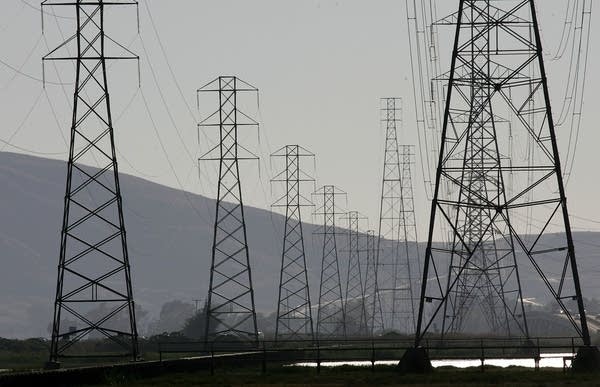PUC to decide on huge powerline project
Go Deeper.
Create an account or log in to save stories.
Like this?
Thanks for liking this story! We have added it to a list of your favorite stories.

A consortium of energy companies is requesting permission to build the powerlines.
The utilities claim that Minnesota's power grid can't adequately supply the state's power needs, and want to build large transmission lines along populated areas in the state.
Under the proposal, CapX 2020 transmission lines would run along three major corridors:
Turn Up Your Support
MPR News helps you turn down the noise and build shared understanding. Turn up your support for this public resource and keep trusted journalism accessible to all.
A 250-mile 345 kilovolt line from Fargo, N.D., to Monitcello, Minn.
A 200-mile line of the same size from Brookings, S.D., to Hampton, Minn. near the Twin Cities. That line also includes a segment from Marshall, Minn. to Granite Falls, Minn.
A 150-mile line from Hampton south to Rochester and east to La Crosse, Wis.
Two additional 161 kV lines would also be built near Rochester.
These powerlines are not the only proposed projects hoping to criss-cross the state.
ITC Holdings Group of Michigan wants to build a series of 765 kV transmission lines across seven states, including Minnesota. The company has dubbed the lines the "Green Power Express" because they would run along wind corridors, and potentially send renewable wind power to points east.

Another project recently proposed by Xcel Energy would upgrade a power line from Granite Falls to Shakopee from the current 230 kV line to a double-circuit 345 kV. These lines would be in addition to the CapX 2020 proposal.
All of these lines could carry wind power to points east, but at the moment no regulating agency requires they only transport wind energy.
Xcel Energy currently gets 7 percent of its power from wind. That's the largest percentage in the country, according to the trade group American Wind Energy Association.
Environmental and citizen groups say that's not good enough. The group Wind on the Wires wants the Public Utilities Commission to require the utilities carry a minimum amount of wind power on these lines, if they are built. That's one of the issues the commissioners will discuss in the two days of hearings.
They could also vote that the lines aren't needed, which is an argument made by a group called Citizens Energy Task Force. Research conducted by the group found that Xcel Energy's energy demands dropped by 12 percent from 2006 through 2008.
The CapX consortium says that's only due to the recession, and demand will rebound making the lines necessary.
Still others argue that the lines are an environmental and health hazard. One alternative to these extensive powerlines is "smart grids," which involve updated technology that monitors energy use, and sends energy only to places where it's being used.
But smart grids are not the question at hand at the PUC. The Public Utilities Commission will determine whether 345 kV lines are needed.
CapX has been slowly making its way down the bureaucratic path for three years now, and staff at the PUC recommend approving the project as it is proposed.
The utilities in the CapX 2020 consortium are Xcel Energy, Central Minnesota Municipal Power Agency, Dairyland Power Cooperative, Minnesota Power, Missouri River Energy Services, Otter Tail Power Company, Rochester Public Utilities, Southern Minnesota Municipal Power Agency and Wisconsin Public Power.
Dear reader,
Political debates with family or friends can get heated. But what if there was a way to handle them better?
You can learn how to have civil political conversations with our new e-book!
Download our free e-book, Talking Sense: Have Hard Political Conversations, Better, and learn how to talk without the tension.




